Trends, Cycles, and Spatial Distribution of the Precipitation, Potential Evapotranspiration and Aridity Index in Xinjiang, China
Abstract
1. Introduction
2. Data Sources and Methods
2.1. Overview of the Study Area
2.2. Data Source
2.3. Research Methodology
2.3.1. Aridity Index
2.3.2. Mann–Kendall Test (M–K)
2.3.3. Sliding T-Test
2.3.4. Morlet Wavelets
2.3.5. Theil–Sen Analysis
2.3.6. Spatial Autocorrelation Analysis
3. Results
3.1. Precipitation
3.1.1. Mutation Test and Trend Analysis of the Precipitation
3.1.2. Cycle Analysis of Precipitation
3.1.3. Spatial Distribution of the Precipitation
3.2. Potential Evapotranspiration (ET0)
3.2.1. Mutation Testing and Trend Analysis of the Potential Evapotranspiration
3.2.2. Cycle Analysis of Potential Evapotranspiration
3.2.3. Spatial Distribution of Potential Evapotranspiration
3.3. Aridity Index (AI)
3.3.1. Mutation Test and Trend Analysis of AI
3.3.2. Cycle Analysis of the AI
3.3.3. Spatial Distribution of the AI
4. Discussion
5. Conclusions
- (1)
- The precipitation, potential evapotranspiration, and AI in Xinjiang changed abruptly around 1986, 1971, and 1987, and there were cycles of 39, 29, and 14 years, respectively.
- (2)
- In the past 60 years, the AI in Xinjiang has shown an insignificant decreasing trend with a tendency rate of −1.94/10a, indicating that the climate in Xinjiang has a trend of becoming wetter, and the coefficient of variation was 41.31%, indicating that the interannual fluctuation of the Xinjiang desiccation index was obvious. The potential evapotranspiration and precipitation showed a decreasing and increasing trend with a variable rate of −14.84 mm/10a and 8.58 mm/10a, respectively.
- (3)
- All of Xinjiang belongs to arid and semiarid regions. The spatial distribution of the AI in Xinjiang showed that the southern border was higher than the northern border, and the basin was higher than the mountainous area; the potential evapotranspiration was lower in the northern border than in the southern border; the spatial distribution of precipitation showed that the mountainous area was higher than the basin plain, and the precipitation in the northern border was obviously higher than the southern border, showing a pattern of more in the north and less in the south.
Author Contributions
Funding
Institutional Review Board Statement
Informed Consent Statement
Data Availability Statement
Conflicts of Interest
Appendix A
| Index | Precipitation | Average Temperature |
|---|---|---|
| Moran index | 0.41 | 0.33 |
| Z-score | 6.66 | 5.32 |


References
- Yanping, Q.; Jianqiang, L.; Juan, L.; Zhicheng, S.; Bing, Q.; Aihua, L. A quantitative framework for assessing drought disaster risk and key techniques. Adv. Water Sci. 2014, 25, 297–304. [Google Scholar] [CrossRef]
- Zhang, B.; Wu, P.; Zhao, X.; Wang, Y.; Gao, X.; Cao, X. A drought hazard assessment index based on the VIC-PDSI model and its application on the Loess Plateau, China. Theor. Appl. Climatol. 2013, 114, 125–138. [Google Scholar] [CrossRef]
- Zhang, J.; Mu, Q.; Huang, J. Assessing the remotely sensed Drought Severity Index for agricultural drought monitoring and impact analysis in North China. Ecol. Indic. 2016, 63, 296–309. [Google Scholar] [CrossRef]
- Qin, L.; Qiang, Z.; Qingzhong, H.; Peijun, S. Nonparametric integrated agro-meteorological drought monitoring in China:New monitoring technique and applicability. Acta Geogr. Sin. 2018, 73, 67–80. [Google Scholar]
- Qing, P.; Ranghui, W.; Yelin, J.; Xiaoquan, W. Adaptability of drought situation monitor in Xinjiang with the NDVI-LST index. Acta Ecol. Sin. 2018, 38, 4694–4703. [Google Scholar]
- Junqiang, Y.; Weiyi, M.; Jing, C.; Tuoliewubieke, D. Signal and impact of wet-to-dry shift over Xinjiang, China. Acta Geogr. Sin. 2021, 76, 57–72. [Google Scholar]
- Hao, Z.; Singh, V.P. Drought characterization from a multivariate perspective: A review. J. Hydrol. 2015, 527, 668–678. [Google Scholar] [CrossRef]
- Zhang, Q.; Yao, Y.; Li, Y.; Huang, J.; Ma, Z.; Wang, Z.; Wang, S.; Wang, Y.; Zhang, Y. Causes and Changes of Drought in China: Research Progress and Prospects. J. Meteorol. Res. 2020, 34, 460–481. [Google Scholar] [CrossRef]
- Qiang, Z.; Liang, Z.; Xiancheng, C.; Jian, Z. Progresses and Challengesin Drought Assessment and Monitoring. Adv. Earth Sci. 2011, 26, 763–778. [Google Scholar]
- Xianfeng, L.; Xiufang, Z.; Yaozhong, P.; Shuangshuang, L.; Yanxu, L. Agricultural drought monitor: Progress, challenges and prospect. Acta Geogr. Sin. 2015, 70, 1835–1848. [Google Scholar]
- Li, Y.P.; Chen, Y.N.; Li, Z. Dry/wet pattern changes in global dryland areas over the past six decades. Glob. Planet. Chang. 2019, 178, 184–192. [Google Scholar] [CrossRef]
- Lijun, C.; Huilan, S.; Xiaoli, L.; Lele, Z.; Baobao, L.; Tianyi, L. Spatio-temporal evolution of the extreme dry and wet events in Tianshan Mountains, Xinjiang, China. Arid Zone Res. 2021, 38, 188–197. [Google Scholar] [CrossRef]
- Pei, X.; Yan-ling, G.; Yu-hu, Z.; Liu, X. Precipitation and drought characteristics in Xinjiang during 1961-2015. Arid Land Geogr. 2017, 40, 332–339. [Google Scholar] [CrossRef]
- Junwei, X.; Jianghua, Z.; Zhihui, L. SPEI-based Spatiotemporal Variation of Drought in Xinjiang. Arid Zone Res. 2016, 33, 338–344. [Google Scholar] [CrossRef]
- Xicheng, Z.; Changchun, X.; Jia, S.; Xiaofei, L. Analysis of drought characteristics in Xinjiang based on remote sensing DSI. Jiangsu Agric. Sci. 2020, 48, 239–246. [Google Scholar] [CrossRef]
- Jing, H.; Yun, Z.; Mingxiu, W.; Fang, W.; Zhi, T.; Hao, H. Spatial and temporal distribution characteristics of drought and its relationship with meteorological factors in Xinjiang in last 17 years. Acta Ecol. Sin. 2020, 40, 1077–1088. [Google Scholar]
- Zhou, Y.; Zhou, P.; Jin, J.; Wu, C.; Cui, Y.; Zhang, Y.; Tong, F. Drought identification based on Palmer drought severity index and return period analysis of drought characteristics in Huaibei Plain China. Environ. Res. 2022, 212. [Google Scholar] [CrossRef]
- Vysakh, A.; Kumar, B.A. Drought analysis using Standardized Precipitation Index (SPI) in Kerala. J. Agrometeorol. 2019, 21, 154–159. [Google Scholar]
- Manzano, A.; Clemente, M.A.; Morata, A.; Yolanda Luna, M.; Begueria, S.; Vicente-Serrano, S.M.; Luisa Martin, M. Analysis of the atmospheric circulation pattern effects over SPEI drought index in Spain. Atmos. Res. 2019, 230. [Google Scholar] [CrossRef]
- Van Hoek, M.; Jia, L.; Zhou, J.; Zheng, C.; Menenti, M. Early Drought Detection by Spectral Analysis of Satellite Time Series of Precipitation and Normalized Difference Vegetation Index (NDVI). Remote Sens. 2016, 8, 422. [Google Scholar] [CrossRef]
- Cong, D.; Zhao, S.; Li, X.; Zhuang, X.; Chen, C. Temporal and spatial distribution of drought in Northeast China based on temperature vegetation drought index (TVDI) from 2001–2013. In Proceedings of the 36th IEEE International Geoscience and Remote Sensing Symposium (IGARSS), Beijing, China, 10–15 July 2016; pp. 4241–4244. [Google Scholar]
- Sui, Y.; Huang, W.-H.; Yang, X.-G.; Li, M.-S. Characteristics and adaption of seasonal drought in southern China under the background of global climate change. II. Spatiotemporal characteristics of drought for wintering grain- and oil crops based on crop water deficit index. J. Appl. Ecol. 2012, 23, 2467–2476. [Google Scholar]
- Junfang, Z.; Jianping, G.; Jingwen, X.; Fei, M.; Xiaoguang, Y.; Yanhong, Z. Trends of Chinese dry-wet condition based on wetness index. Trans. CSAE 2010, 26, 18–24+386–387. [Google Scholar]
- Qi, H.; Bei, D.; Xuebiao, P.; Huifei, J.; Zhihua, P.; Yu, Q.; Changxiu, S.; Menglin, D.; Ziwei, Y.; Liting, H. Spatiotemporal variation and causes analysis of dry-wet climate over period of 1961–2014 in China. Trans. CSAE 2017, 33, 124–132+315. [Google Scholar]
- Hongxing, Z.; Jing, L. Long-term trends of aridity index and its sensitivity to climate factors in Northeast China: 1971–2008. Geogr. Res. 2011, 30, 1765–1774. [Google Scholar]
- Yu, X.; Yan-fei, W.; Gang, X.; Min, L. Characteristics of Surface Humidity and Extreme Drought/Wet Events in Yangtze River Delta. J. Nat. Resour. 2017, 32, 1579–1590. [Google Scholar]
- Qingwen, Z.; Ningbo, C.; Lushan, Z.; Yang, X.; Qian, L.; Feipeng, L. Seasonal drought characteristics based on relative moisture index in Yunnan Province. Agric. Res. Arid. Areas 2020, 38, 278–284. [Google Scholar]
- Zejiang, Z.; Baoqi, L.; Ziyue, Z.; Xiaoyong, D.; Jinpu, G. Spatial and temporal distribution characteristics of the humid index in north China plain. J. China Inst. Water Resour. Hydropower Res. 2022. [Google Scholar] [CrossRef]
- Jun, D.; Kanshe, Z.; Lei, Y. Climate change tendency of surface humidity index in Chang Tang Nature Reserve of Tibet from 1971 to 2018. Sci. Soil Water Conserv. 2021, 19, 13–23. [Google Scholar] [CrossRef]
- Li, Y.; Feng, A.; Liu, W.; Ma, X.; Dong, G. Variation of Aridity Index and the Role of Climate Variables in the Southwest China. Water 2017, 9, 743. [Google Scholar] [CrossRef]
- Geng, M.; Liu, P.; Qiao, X.; Wang, M.; Wang, X. Spatial and Temporal Characteristics of Extreme Dry and Wet Events in Xinjiang from 1960 to 2020 and the Analysis of Influencing Factors. Atmosphere 2022, 13, 1067. [Google Scholar] [CrossRef]
- Yanlong, Z.; Liu, P. Study on Temporal and Spatial Variation of the Dry-wet and Its Influence Factors in Xinjiang Based on Aridity Index. J. Nat. Resour. 2016, 31, 658–671. [Google Scholar]
- Wu, Y.; Zhang, G.; Shen, H.; Xu, Y.J.; Bake, B. Attribute Analysis of Aridity Variability in North Xinjiang, China. Adv. Meteorol. 2016, 2016, 9610960. [Google Scholar] [CrossRef]
- Das, S. Extreme rainfall estimation at ungauged locations: Information that needs to be included in low-lying monsoon climate regions like Bangladesh. J. Hydrol. 2021, 601. [Google Scholar] [CrossRef]
- Das, S.; Islam, A.M.T. Assessment of mapping of annual average rainfall in a tropical country like Bangladesh: Remotely sensed output vs. kriging estimate. Theor. Appl. Climatol. 2021, 146, 111–123. [Google Scholar] [CrossRef]
- Jingyun, Z.; Yunhe, Y.; Bingyuan, L. A New Scheme for Climate Regionalization in China. Acta Geogr. Sin. 2010, 65, 3–12. [Google Scholar]
- Pereira, L.S.; Allen, R.G.; Smith, M.; Raes, D. Crop evapotranspiration estimation with FAO56: Past and future. Agric. Water Manag. 2015, 147, 4–20. [Google Scholar] [CrossRef]
- Sharma, V.; Adhikari, K. Rainfall and rainy days trend and ENSO phenomena in Himalayan Kingdom of Bhutan. Acta Geophys. 2022, 70, 1855–1869. [Google Scholar] [CrossRef]
- Kendall, M.G. A new measure of rank correlation. Biometrika 1938, 30, 81–93. [Google Scholar] [CrossRef]
- Mann, H.B. Nonparametric Tests Against Trend. Econometrica 1945, 13, 245–259. [Google Scholar] [CrossRef]
- Yixuan, H.; Zongxue, X.; Hao, C.; Tiewen, F.; Donghui, W. Spatiotemporal variability of precipitation over Guangdong Province during flood seasons of 1960 to 2020. J. Hydroelectr. Eng. 2022, 41, 70–82. [Google Scholar]
- Fengying, W. Progresses on Climatological Statistical Diagnosis and Prediction Methods—In Commemoration of the 50 Anniversaries of CAMS Establishment. J. Appl. Meteorol. Sci. 2006, 736–742. [Google Scholar]
- Yan, Q. Variation of Rainfall, Temperature and Evaporation in the Region of Da Chaidan. J. Irrig. Drain. 2021, 40, 115–121. [Google Scholar] [CrossRef]
- Nigenare, A.; Jianli, D.; Xiangyu, G.; Qingling, B. Variation characteristics ofactual evapotranspiration and meteorological elements in the Ebinur Lake basin from 1960 to 2017. Acta Geogr. Sin. 2021, 76, 1177–1192. [Google Scholar]
- Cao, R.; Jiang, W.; Yuan, L.; Wang, W.; Lv, Z.; Chen, Z. Inter-annual variations in vegetation and their response to climatic factors in the upper catchments of the Yellow River from 2000 to 2010. J. Geogr. Sci. 2014, 24, 963–979. [Google Scholar] [CrossRef]
- Ming, L.; Weixia, H.; Lianzhi, Z.; Guiwen, W.; Xurong, C. Risk analysis of meteorological drought in Northeast China based on standardized precipitation evapotranspiration index. J. Arid Land Resour. Environ. 2018, 32, 134–139. [Google Scholar] [CrossRef]
- Wang, X.; Zhao, W.; Zhang, T.; Qiu, Y.; Ma, P.; Li, L.; Wang, L.; Wang, M.; Zheng, D.; Zhao, W. Analysis of the Characteristics of Ozone Pollution in the North China Plain from 2016 to 2020. Atmosphere 2022, 13, 715. [Google Scholar] [CrossRef]
- Yang, D.; Jinyong, Z.; Jing, Z.; Yicheng, F.; Wenqi, P.; Quchang, C.; Yanyan, L. Spatial Differences in Water Quality and Spatial Autocorrelation Analysis of Eutrophication in Songhua Lake. Environ. Sci. 2021, 42, 2232–2239. [Google Scholar] [CrossRef]
- Dai, A. Characteristics and trends in various forms of the Palmer Drought Severity Index during 1900-2008. J. Geophys. Res. Atmos. 2011, 116. [Google Scholar] [CrossRef]
- Mondal, S.K.; Huang, J.; Wang, Y.; Su, B.; Zhai, J.; Tao, H.; Wang, G.; Fischer, T.; Wen, S.; Jiang, T. Doubling of the population exposed to drought over South Asia: CMIP6 multi-model-based analysis. Sci. Total Environ. 2021, 771. [Google Scholar] [CrossRef]
- Yaning, C.; Zhi, L.; Yuting, F.; Huaijun, W.; Gonghuan, F. Research progress on the impact of climate change on water resources in the arid region of Northwest China. Acta Geogr. Sin. 2014, 69, 1295–1304. [Google Scholar]
- Zhang, C.; Ren, Y.; Cao, L.; Wu, J.; Zhang, S.; Hu, C.; Zhujie, S. Characteristics of Dry-Wet Climate Change in China during the Past 60 Years and Its Trends Projection. Atmosphere 2022, 13, 275. [Google Scholar] [CrossRef]
- Huo, Z.; Dai, X.; Feng, S.; Kang, S.; Huang, G. Effect of climate change on reference evapotranspiration and aridity index in arid region of China. J. Hydrol. 2013, 492, 24–34. [Google Scholar] [CrossRef]
- Li-li, L.; Lei, H.; Yong-gui, H.; Yang, G.; Ling4, P. Spatio-temporal variations of aridity index and its response to climate factors in Northwest China during 1989–2019. Chin. J. Appl. Ecol. 2021, 32, 4050–4058. [Google Scholar] [CrossRef]
- Wang, M.; Liu, P.; Qiao, X.; Si, W.; Liu, L. Spatio-Temporal Characteristics of Dry-Wet Conditions and Boundaries in Five Provinces of Northwest China from 1960 to 2020. Atmosphere 2021, 12, 1499. [Google Scholar] [CrossRef]
- Getis, A.; Ord, J.K. The Analysis of Spatial Association by Use of Distance Statistics. Geogr. Anal. 1992, 24, 189–206. [Google Scholar] [CrossRef]



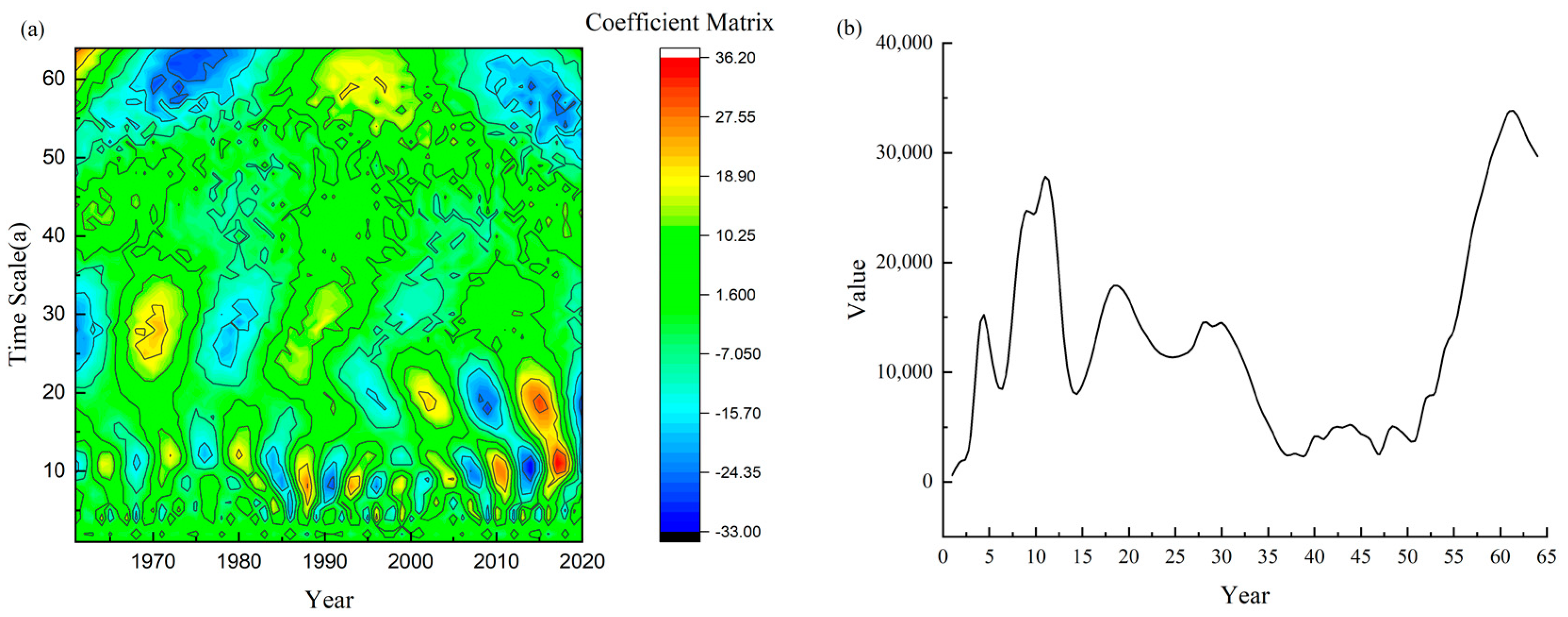
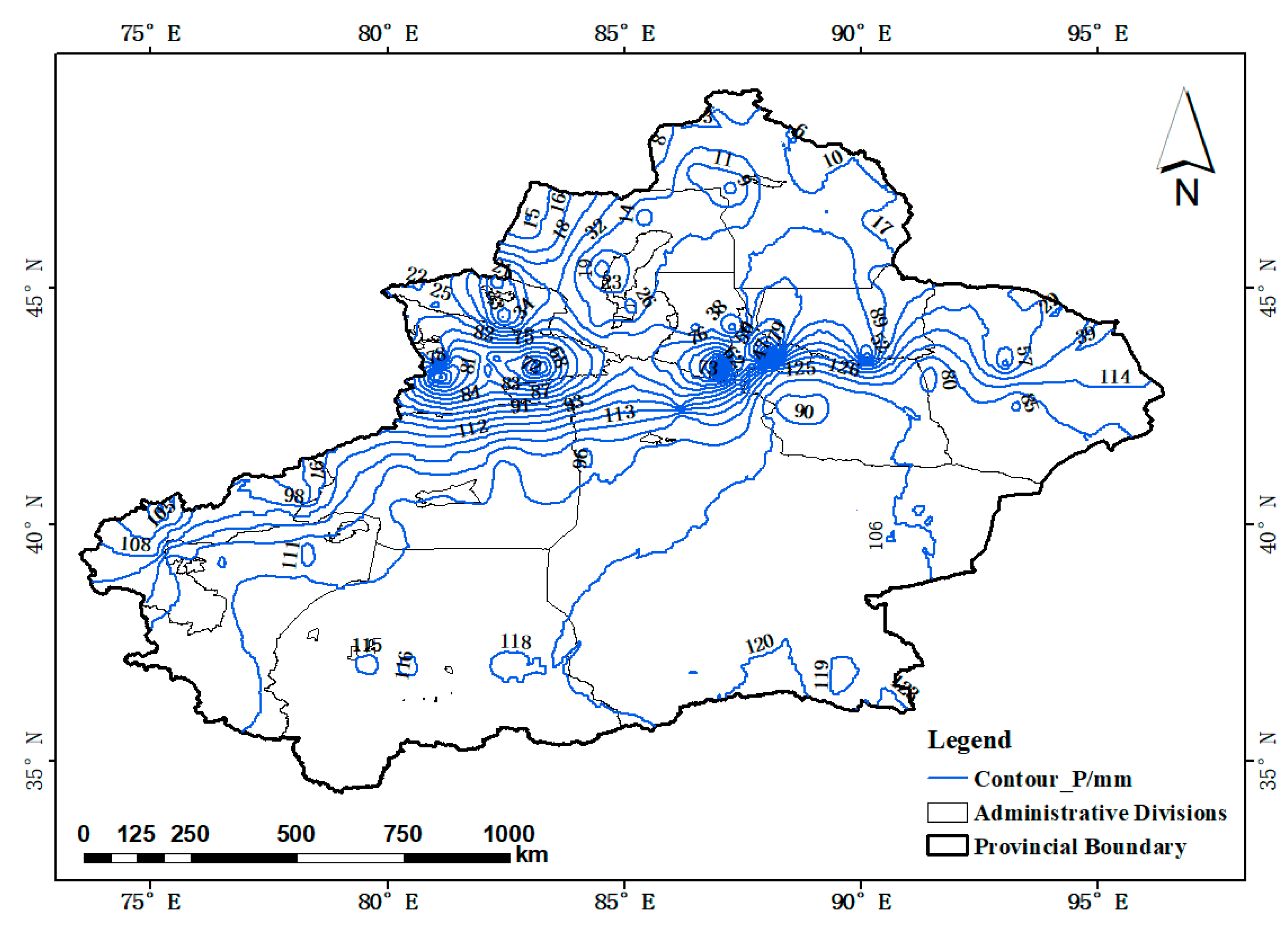

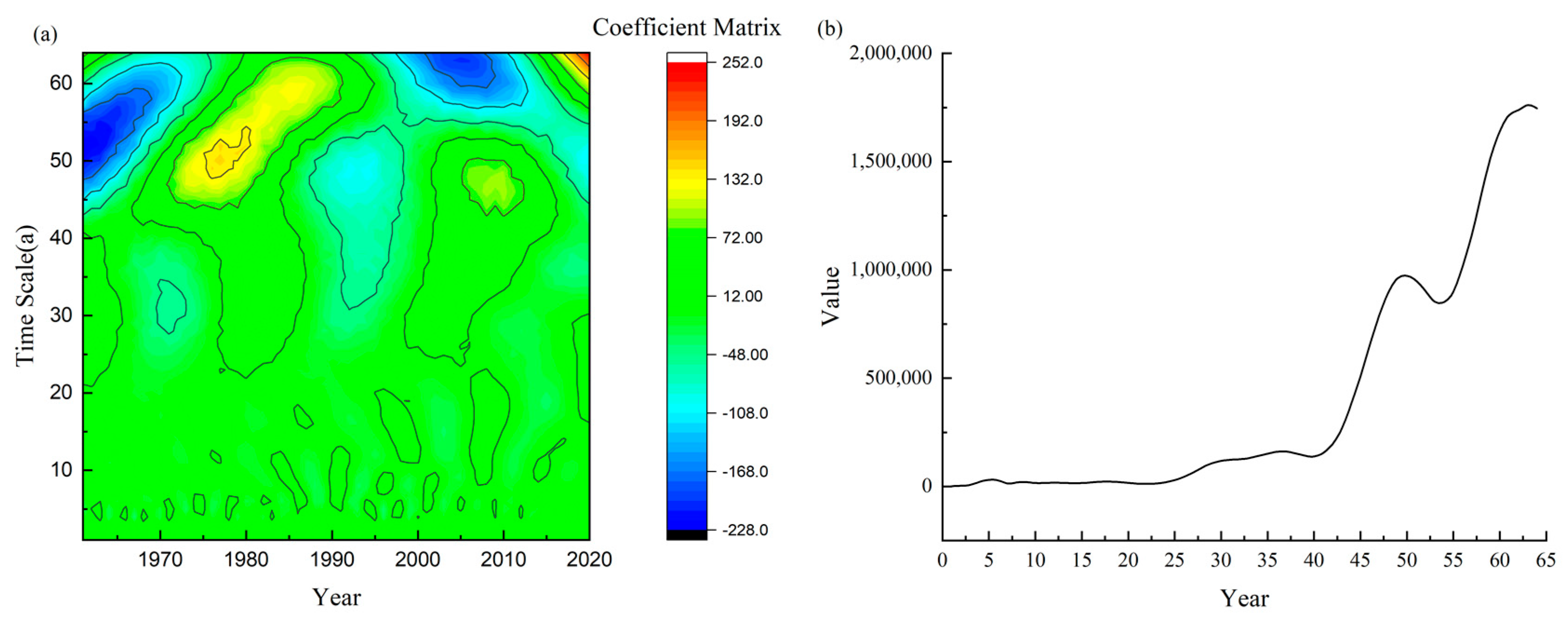


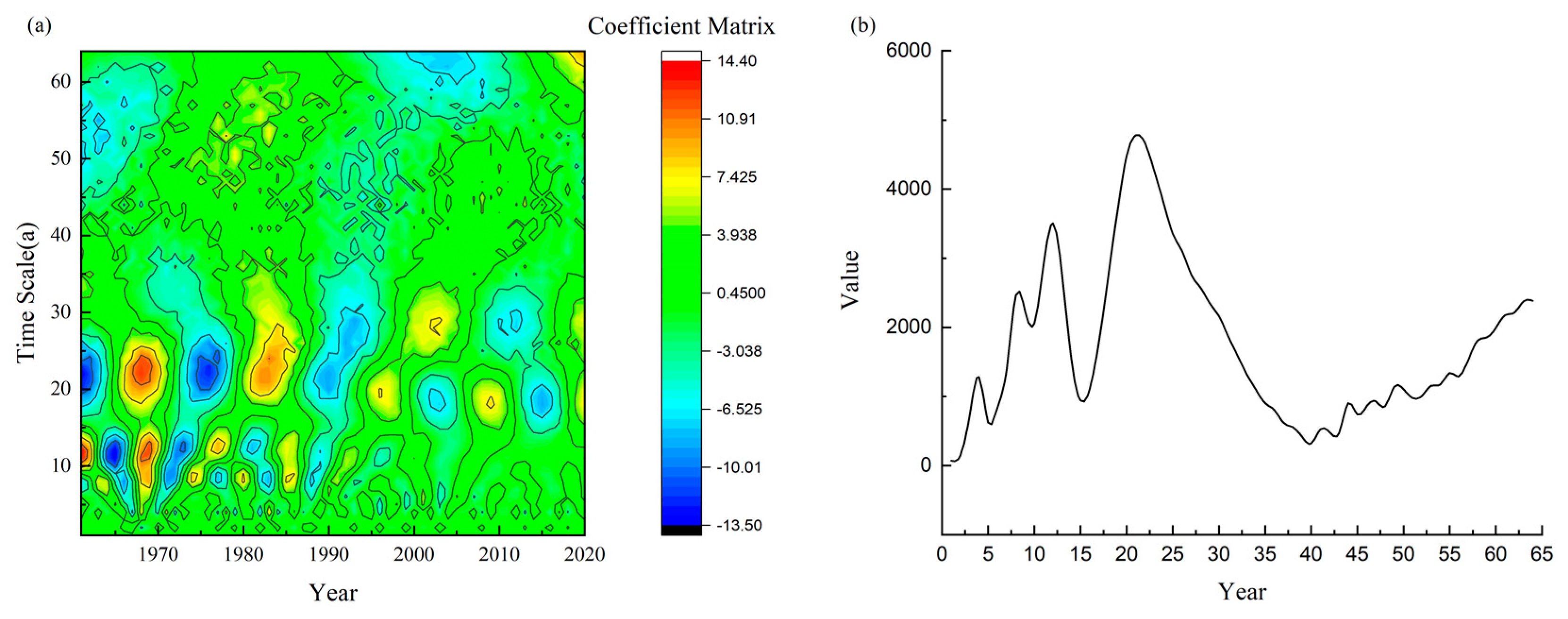
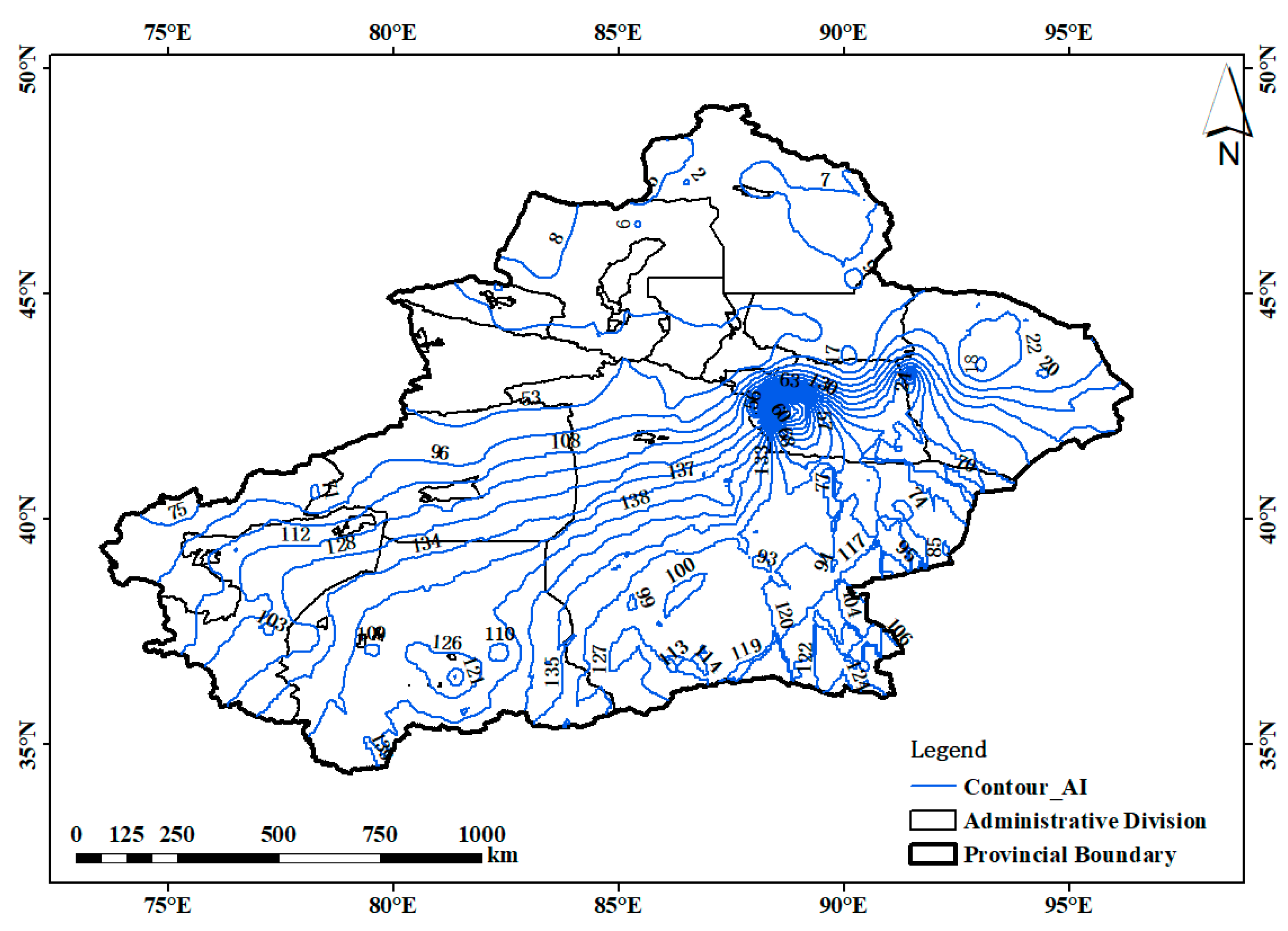
Disclaimer/Publisher’s Note: The statements, opinions and data contained in all publications are solely those of the individual author(s) and contributor(s) and not of MDPI and/or the editor(s). MDPI and/or the editor(s) disclaim responsibility for any injury to people or property resulting from any ideas, methods, instructions or products referred to in the content. |
© 2022 by the authors. Licensee MDPI, Basel, Switzerland. This article is an open access article distributed under the terms and conditions of the Creative Commons Attribution (CC BY) license (https://creativecommons.org/licenses/by/4.0/).
Share and Cite
Zhang, Y.; Long, A.; Lv, T.; Deng, X.; Wang, Y.; Pang, N.; Lai, X.; Gu, X. Trends, Cycles, and Spatial Distribution of the Precipitation, Potential Evapotranspiration and Aridity Index in Xinjiang, China. Water 2023, 15, 62. https://doi.org/10.3390/w15010062
Zhang Y, Long A, Lv T, Deng X, Wang Y, Pang N, Lai X, Gu X. Trends, Cycles, and Spatial Distribution of the Precipitation, Potential Evapotranspiration and Aridity Index in Xinjiang, China. Water. 2023; 15(1):62. https://doi.org/10.3390/w15010062
Chicago/Turabian StyleZhang, Yunlei, Aihua Long, Tingbo Lv, Xiaoya Deng, Yanyun Wang, Ning Pang, Xiaoying Lai, and Xinchen Gu. 2023. "Trends, Cycles, and Spatial Distribution of the Precipitation, Potential Evapotranspiration and Aridity Index in Xinjiang, China" Water 15, no. 1: 62. https://doi.org/10.3390/w15010062
APA StyleZhang, Y., Long, A., Lv, T., Deng, X., Wang, Y., Pang, N., Lai, X., & Gu, X. (2023). Trends, Cycles, and Spatial Distribution of the Precipitation, Potential Evapotranspiration and Aridity Index in Xinjiang, China. Water, 15(1), 62. https://doi.org/10.3390/w15010062








